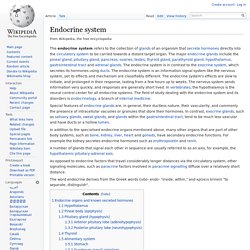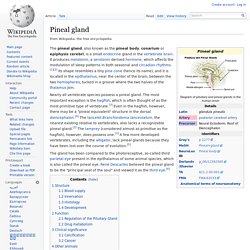

Endocrine system. In addition to the specialised endocrine organs mentioned above, many other organs that are part of other body systems, such as bone, kidney, liver, heart and gonads, have secondary endocrine functions.

For example the kidney secretes endocrine hormones such as erythropoietin and renin. A number of glands that signal each other in sequence are usually referred to as an axis, for example, the hypothalamic-pituitary-adrenal axis. As opposed to endocrine factors that travel considerably longer distances via the circulatory system, other signaling molecules, such as paracrine factors involved in paracrine signalling diffuse over a relatively short distance.
The word endocrine derives from the Greek words ἐνδο- endo- "inside, within," and κρίνειν krinein "to separate, distinguish". Endocrine organs and known secreted hormones[edit] Endocrine glands in the human head and neck and their hormones Hypothalamus[edit] Pineal body (epiphysis)[edit] Pituitary gland (hypophysis)[edit] Thyroid[edit] Skin[edit] Pineal Gland. The pineal gland, also known as the pineal body, conarium or epiphysis cerebri, is a small endocrine gland in the vertebrate brain.

It produces melatonin, a serotonin derived hormone, which affects the modulation of sleep patterns in both seasonal and circadian rhythms.[1][2] Its shape resembles a tiny pine cone (hence its name), and it is located in the epithalamus, near the center of the brain, between the two hemispheres, tucked in a groove where the two halves of the thalamus join. Nearly all vertebrate species possess a pineal gland.
The gland has been compared to the photoreceptive, so-called third parietal eye present in the epithalamus of some animal species, which is also called the pineal eye. René Descartes believed the pineal gland to be the "principal seat of the soul" and viewed it as the third eye.[6] Structure[edit] Blood supply[edit] Innervation[edit] The Mammalian Pineal Gland May Be The Third Eye. Author: Prof.

Lili Feng and et al 'Modern medical dissection has already discovered that the front section of the pineal gland is equipped with the complete structure of a human eye. Because it grows inside one's skull, it is thus said to be a vestigial eye. Whether it is a vestigial eye or not, our community of cultivators has reservations. In recent years, scientists gradually discovered that the mammalian pineal gland is photo sensitive. Photic information reaches it via a multi synaptic pathway originating in retina and passing through suprachiasmatic regions of the hypothalamus (1). Five years after the publication of Zhuan Falun, Lucas et al. (5) published a paper in Science, one of the most well known scientific journals. It is well known, with neither retinal photoreceptors nor optic signal transduction pathways, that the conventional visual pathway cannot be established. Articles - Fluoride & the Pineal Gland: Study Published in Caries Research.
Fluoride & the Pineal Gland: Study Published in Caries Research International Fluoride Information Network March 27, 2001 IFIN Bulletin #269: Fluoride and the pineal gland.

Luke published. Dear All, The wheels of science grind very slowly. Finally, the first half of the work that was the subject of Jennifer Luke's Ph.D. thesis; presentation in Bellingham, Washington (ISFR conference) in 1998 and a videotaped interview I had with her (see www.fluoridealert.org/videos.htm), has been published in Caries Research (see abstract below). In my view this work is of enormous importance and could be (or should be) the scientific straw that breaks the camel's back of fluoridation.
Many of our subscribers are familiar with the details but let me repeat them here. The one activity that Luke is particularly interested in is the onset of puberty. I have a copy of Luke's Ph.D. thesis and would be willing to share it with those who have a serious scientific interest in this issue. Philosophy, Vol. 54, No. 209 (Jul., 1979), pp. 380-384. BrianKelch5.pdf (application/pdf Object) AndreaPaperNewFormat(2).pdf (application/pdf Object) Pineal Tumors. Fluoride Health Effects Database.